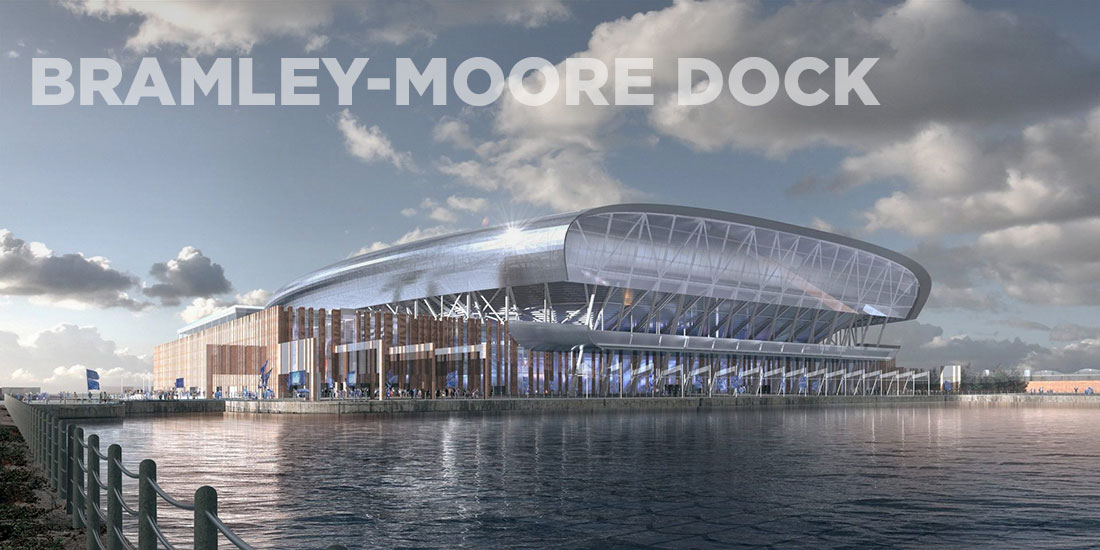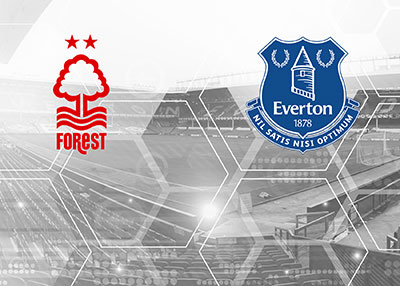Basic Details
Capacity: 52,888
Cost: ~£500m, rising to ~£760m
Architecture/Design: Meis
Construction Contractor Laing O'Rourke
Home End Capacity: ~13,000
Construction started: 26 July, 2021
Completion date: Est. December 2024
It's the dream that appeared to have died a painful death when Everton's plans to relocate to the King's Dock collapsed in 2004 – namely, a new stadium on the banks of the royal blue Mersey. While the site that was eventually taken by the Echo Arena would have been a perfect spot for the Toffees' new ground, the club are making good on ambitious plans at the next best available waterfront location, two miles to the north at Bramley-Moore Dock.
If all goes well, two decades after the Kings Dock proposal fell by the wayside, Everton will be kicking off at a brand new, £760m purpose-built stadium on Liverpool's north docks at the start of the 2025-26 season.
That it's even possible is largely down to the arrival on the scene of Farhad Moshiri as a major shareholder in Everton in February 2016, which finally gave the club the financial resources to tackle a long-standing stadium issue that dated back 20 years to former chairman, Peter Johnson's first proposal to up sticks from Goodison Park.
Credited with a personal fortune of around £1.2bn at the time, Moshiri sold the 15% holding he had in Arsenal FC in partnership with Alisher Usmanov and acquired an initial 49.9% stake in the Toffees, buying out Robert Earl completely and part of the holdings of Bill Kenwright and Jon Woods before eventually increasing his holdings to 94.1%.
Within weeks of his arrival, it emerged that Everton's hierarchy were exploring two very different brownfield sites within the city for a potential relocation of the club from Goodison Park, having narrowed their options down from around 50 potential locations in the Merseyside area.
- Project Timeline
- Site Selection and Land Purchase Agreement
- Everton's Principles of Development
- Design & Construction
Project Timeline
- October 2016 – Club hiearchy conduct site visits at Bramley-Moore Dock and Stonebridge Cross
- March 2017 – Land Purchase Agreement in place
- June 2017 – Bramley-Moore Dock mooted as designated athletics stadium for 2022 Commonwealth Games bid
- November 2017 – Everton exchange land-lease contracts for docks site
- January 2018 – Everton unveil 11 key principles for stadium move
- March 2018 – Club reveal results of first survey of supporters over proposed relocation
- March 2018 – Labour members request city meeting to discuss proposed stadium loan for Everton
- April 2018 – Face-to-face consultation with fans over Bramley-Moore Dock begins
- August 2018 – Colin Chong hired as Stadium Development Director
- November 2018 – First-stage public consultation begins; public backing received from local business and community interests
- December 2018 –52,000-seat stadium proposed for Bramley-Moore Dock
- February 2019 – Results of first public consultation released
- July 2019 – First artist renderings of Bramley-Moore Dock revealed
- July 2019 – Second public consultation begins
- October 2019 – Results of second public consulation revealed
- December 2019 – Planning Appliction for Bramley-Moore Dock submitted to Liverpool City Council; Updated images revealed
- January 2020 – USM purchase naming rights option for Bramley-Moore Dock
- February 2020 – Laing O'Rourke selected as 'preferred contractor' for stadium construction
- February 2020 – Planning Application published on LCC portal
- June 2020 – Designer and architect Dan Meis announces he is "no longer engaged" in the Everton stadium project
- August 2020 – Revised Planning Application submitted
- September 2020 – Historic England recommends that Bramley-Moore Dock project be called in by Government
- December 2020 – Planning Application decision delayed until 2021
- February 2021 – LCC Planning Officer recomments BMD project be approved
- February 2021 – Unanimous planning approval from LCC
- March 2021 – Final approval granted from the Secretary of State
- June 2021 – Construction start date finalised; preliminary site work begins
- 10 August 2021 – Everton hold project commencement ceremony to mark the breaking of ground
- October 2021 – Infill of Bramley-Moore Dock begins; Dan Meis rejoins the project
- December 2021 – Dredging and infill project of the dock is completed; first above-ground structure is erected at the site
- December 2022 – All four corners of the stadium are in place with the first terracing and roof trusses being installed
- March 2023 – "Everton Way" concept is unveiled allowing supporters to buy engraved bricks to be installed outside the new ground
- August 2023 – Tragedy strikes the construction project as lifelong Evertonian Michael Jones dies in an accident on the site at Bramley-Moore Dock
- September 2023 – MSP Sports Capital confirm a £100m loan to help fund the next phase of construction
- October 2023 – Everton receive confirmation that their new stadium will host games at Euro 2028 as the UK and Ireland are named as hosts
- October 2023 – The final steel section of the roof structure is lifted into place; the first seats are installed on the South Stand
- July 2024 – Final piece of barrel-cladding is lifted into place on the stadium's roof; preparation of the pitch begins
- December 2024 – Construction complete
- August 2025 – First competitive senior men's match
Site Selection and Land Acquisition
Stonebridge Cross
Situated in Croxteth on the west side of the M57 from Knowsley, the site of Everton's last serious attempt to relocate in 2007 before the Destination Kirkby scheme was called in by the Government, Stonebridge Cross would offer more of an out-of-town experience akin to many of the newer football stadia developments of the past 20 years.
The area had long been earmarked for regeneration given it's prime location off the East Lancs road and the nearby motorway and was considered at one time by online retail and distribution giant Amazon for a warehouse complex. Housing developer Cobalt Housing were also weighing up the area for the construction of new housing units while Liverpool City Council were keen to build a new access road to "open up" Stonebridge Cross for future development and investment.
As the largest development plot in Liverpool, the site had obvious advantages for the construction of a stadium, not least space, transport links and readiness. Compared with other sites closer to the city, Stonebridge Cross offered a relatively lower cost barrier to entry but, unlike the location at Walton Hall Park that was examined between 2014 and 2016, it would mean moving Everton more than three miles away from its current location in Walton and five-and-a-half miles from the city centre.
Bramley-Moore Dock
While Stonebridge Cross was evocative of the 2007 Destination Kirkby proposal in that it promised to move Everton to an industrial estate environment on the outskirts of town, an area selected in Liverpool's north docklands area offered the club a second chance of a home on the banks of the Mersey, a decade and a half after the doomed Kings Dock project was first mooted.
While it was initially reported that the Board were looking at a site at Trafalgar Dock, it was later confirmed that a more ambitious proposal was being explored three docks up at Bramley-Moore Dock, one which would keep the club closer to the city centre and provide the opportunity to build something special on one of the world's most famous waterfronts.
Not surprisingly, it immediately became the option most favoured by supporters and it was largely confirmed at the January 2017 Annual General Meeting that it was the more popular choice among the Board as well. CEO Robert Elstone described the club's progress in making it a reality as "solid" but admitted that it remained a very complex project.
In contrast to the Croxteth site, the docks option would require significantly more preparation work and cost, requiring a that a deal be struck with landowner and developer, the Peel Group, and that the dock itself be filled in to create the footprint for the stadium. A heads of terms agreement with Peel was announced in March 2017, placing the first stepping stone in place towards a potentially iconic stadium on the banks of the Royal Blue Mersey.
Land purchase agreement
Everton took a huge step towards leaving Goodison Park after 125 years with the news in March 2017 that the club had negotiated a land-purchase agreement with Peel Group for Bramley-Moore Dock. In November 2017, the two parties formally signed an agreement for the club to lease land for the new stadium at the site and contracts were exchanged that month.
The lease, which is conditional upon gaining planning consent for the proposed new stadium and securing funding for its construction, was signed under Everton Stadium Development Limited with Peel Land and Property (Ports) and will run for a period of 200 years at a peppercorn rent.
Under the terms of the agreement, Everton effectively control the land upon which a new ground would be built, moving the Blues closer to securing a move away from Goodison Park.
Robert Elstone, Chief Executive at Everton Football Club said: “Clearly this is very positive news. Gaining control of the site was essential for us to be able to move forward with the next stages of the project — finalising the funding agreement with the Council and preparing for the submission of a planning application — both of which we hope to do in the New Year. I'd like to thank Peel as well as Mayor Anderson and his colleagues at the Council for their support in getting us to this point.”
The proposed new stadium will be part of Peel's £5bn Liverpool Waters regeneration scheme which promises to transform the waterfront along Regent Road north of Prince's Dock while the LCC-backed Ten Streets initiative hoped to regenerate the derelict section along Great Howard immediately to the east.
Everton are believed to have negotiated a price of around £22.5m for the site on Liverpool's north docks with commencement of construction dependent on planning permission, the application for which was originally planned for submission late in 2017 or early in 2018 but which was eventually delayed until Decmber 2019 following two public consultations. The club's business plan provided for them staying at Goodison until the end of the 2020-21 season, later revised to 2022-23.
At the time an announcement from the Council outlined the creation of a "special purpose vehicle" whereby LCC would guarantee loans for the stadium's construction, receive a security fee (reported to be around £4m a year) for its trouble and take out a 40-year lease on the site from the funder that they would then sub-lease to Everton. The club could then have the option of acquiring a leasehold interest in the stadium.
The arrangement, which would not have involved any capital from the council but would have allowed Everton to secure funding for the project from a wider spectrum of lenders and most likely at significantly lower interest rates than if they were to go it alone as a higher-risk entity, didn't come to fruition, with the club eventually deciding to seek private funding for the project.
The initial cost analysis based on a 50,000-capacity stadium was £300m but this was later revised upwards to £500m and then £760m on a 52,888 capacity ground.
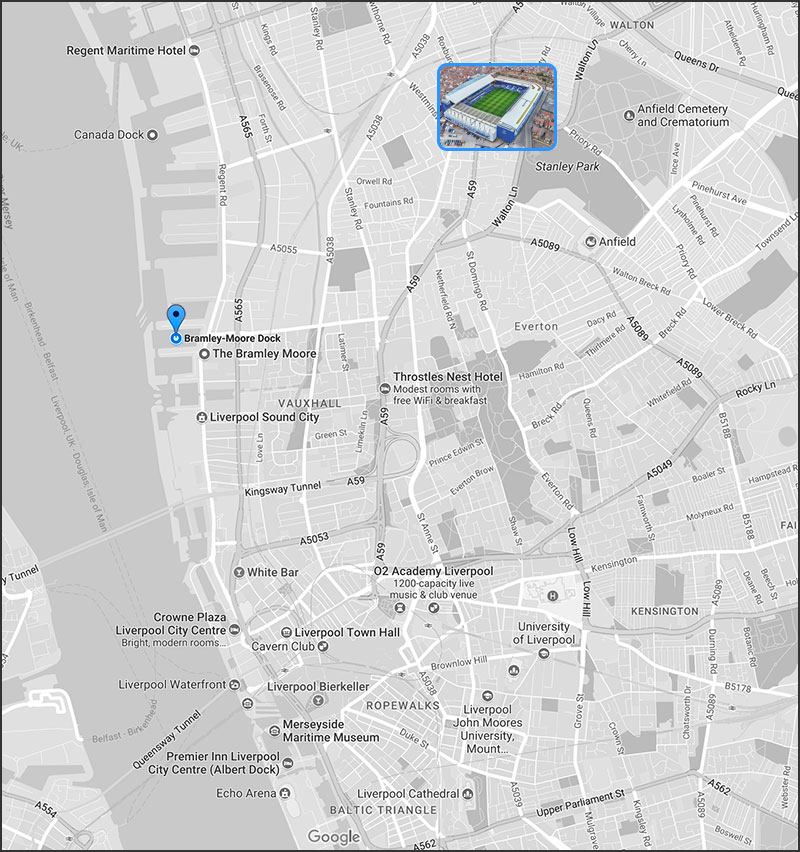
Map of Liverpool showing the location of Bramley-Moore Dock in relation to Goodison Park in Walton
Everton's 11 Principles of Development
The Club have outlined eleven ‘Principles of Development’ for the new stadium development for the Bramley-Moore Dock site in the current project brief. These Principles reflect the Club’s values and aspirations as a community institution, and in keeping with the Club’s spirit of inclusivity, these Principles were shared with the public and stakeholders during the consultation process during 2017 - 2018.
In addition to the requirement for the proposed stadium to provide the highest level of match day facilities for players, staff, and fans, as well as to provide a commercial platform for the Club to achieve its ambitions in an increasingly competitive landscape, the Principles of Development also reaffirmed the Club’s commitment to the surrounding community.
From helping spur economic and social regeneration of the area, to the opening up of a new area to the Public in which heritage maritime assets are preserved and celebrated, the Club endeavors to create a site that is open to all visitors year- round and contributes to the unique character of Liverpool.
The Principles of Development include:
Principle 1: Our Fortress
Our stadium will be a great place to play football. We will prioritise all football-related facilities and ensure all aspects of on-field performance are at the forefront of our plans. Creating and harnessing an atmospheric, intense and passionate environment will optimise our results. Our design will ensure that the benefit of home advantage is maximised. Just as the Gwladys Street has famously done in the past, the support from the home end will ‘suck the ball into the net.’ Our new stadium will be our footballing fortress.
Principle 2: A New Home For Everton
Our new stadium will become our home. Our fans will play a key role in the design and configuration of the new stadium. We will create an environment surrounding the stadium where fans will enjoy congregating and socialising - and an environment inside the stadium that will capture and amplify the intensity and intimacy of Goodison Park.
Principle 3: A Platform For Growth
The new stadium will provide increased capacity, modern and innovative premium seating options, exciting opportunities for our partners and globally showcase our naming rights partner from our unique location. We will create an environment that will encourage repeat visits from our broadcast partners. All of the above will enhance the profitability of the Club and eliminate the financial constraints of Goodison Park.
Principle 4: The People’s Club
Our commitment to affordable ticket pricing will ensure our stadium is accessible to the widest of audiences. Our state- of-the-art facilities will encourage regular visits from all fans irrespective of age or ability. We will endeavour to make the stadium available for use all year round - not just on matchdays. A new ‘living and breathing’ community will develop adjacent to Bramley-Moore Dock. We will forge partnerships with local businesses and ensure our new home captures the spirit of our great City.
Principle 5: An Iconic Landmark for Liverpool
We will develop an iconic stadium at Bramley-Moore Dock. A venue that will sit proudly on our world-famous city skyline; a venue that will complement our City’s rich and envied heritage.
Principle 6: Easy To Get To, Easy To Get Home
Bramley-Moore Dock sits within the historic Liverpool waterfront and close to Goodison Park. Our new home will be easily accessible by road, rail and public transport links.
Principle 7: A Legacy For Goodison Park
We will create a unique and innovative legacy for the Goodison Park site, providing sustainability for businesses and residents for generations to come.
Principle 8: Respecting Heritage
We will respect our maritime heritage, capture the features and essence of our new neighborhood and restore, and make features of, key structures on the site.
Principle 9: Harnessing The Environment
Our aim is to be environmentally efficient in both design and construction and environmentally friendly and sustainable in operation.
Principle 10: Embracing Technology
Our new stadium will provide cutting-edge technology to support matchday entertainment. We will embrace existing and emerging digital solutions. Inside the stadium, high-quality audio-visual systems will form a key part of the matchday experience.
Principle 11: The Right Deal For Liverpool
The stadium development will help kick-start economic regeneration, bringing jobs to the area and acting as a catalyst for further investment. The development presents a much-needed regeneration opportunity for North Liverpool.
Design and Construction
The Site
As part of Liverpool's historic waterfront, Bramley-Moore Dock is situated within the Stanley Dock Conservation Area, a UNESCO World Heritage site, and is bordered to the east by the Grade II listed Regent Road granite wall. The River Mersey forms a natural boundary to the west, with Nelson Dock to the south and the United Utilities waste water treatment plant to the north.
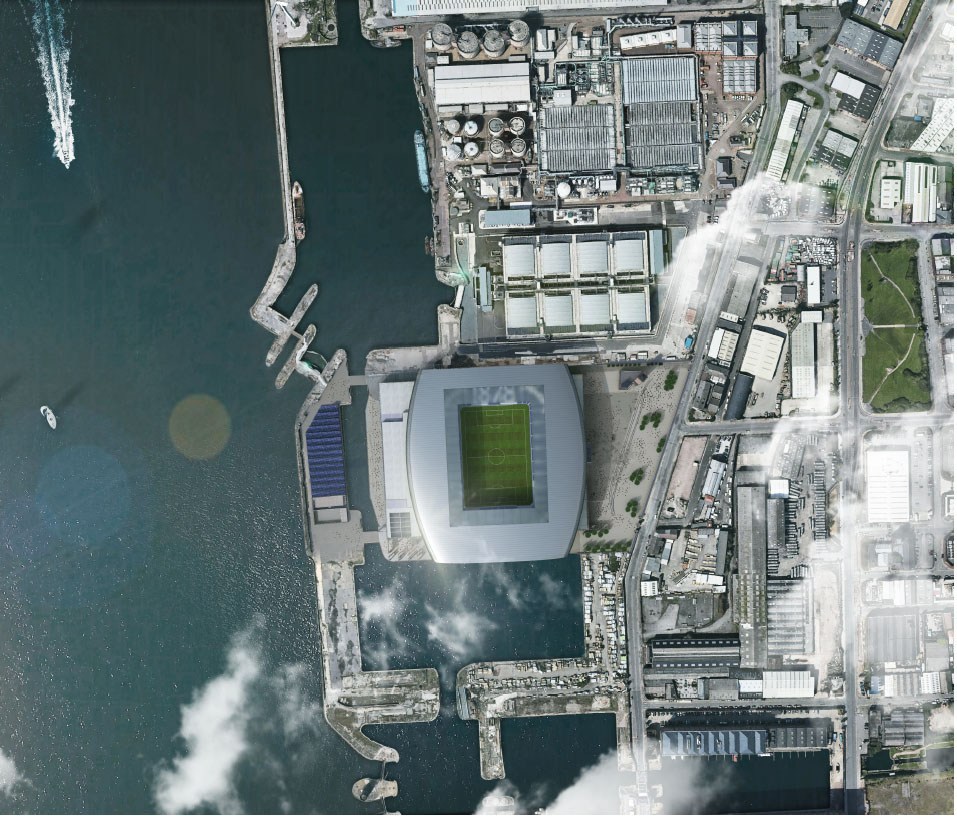
Overhead view of the planned Bramley-Moore Dock stadium, with Nelson Dock immediately to the south
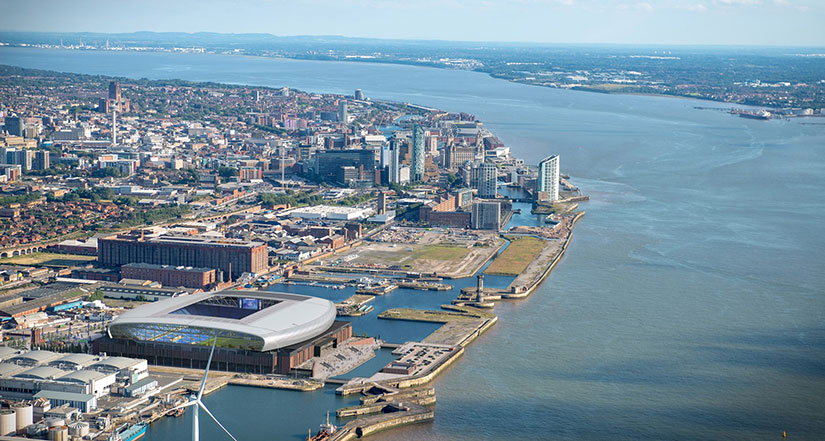
Artists's impression of the Bramley-Moore Dock stadium in-situ, looking south towards Liverpool city centre
Design

In addition to concepts for the Oakland Raiders and San Diego Chargers in the NFL, Meis designed AS Roma's Stadio Della Roma and FC Cincinnati's ground but by owner Dan Meis's own admission, the Bramley-Moore project promised to be a unique assignment and one that quickly became a passion for him. As he wrote in a blog post on his studio's website in September 2017:
I will always remember the words of Robert Elstone: "It should be a 'cauldron of energy', with the steepest stands right on top of the pitch, and a massive home end!" From that moment, I was hooked.
A few weeks later I saw my first game at Goodison, and I fell in love. Like all attractions, there is something magnetic or chemical about it that truly does make one feel like you are "chosen". I knew at that moment that it was different than any project I had ever pursued or any team I have ever followed... it was in my blood.
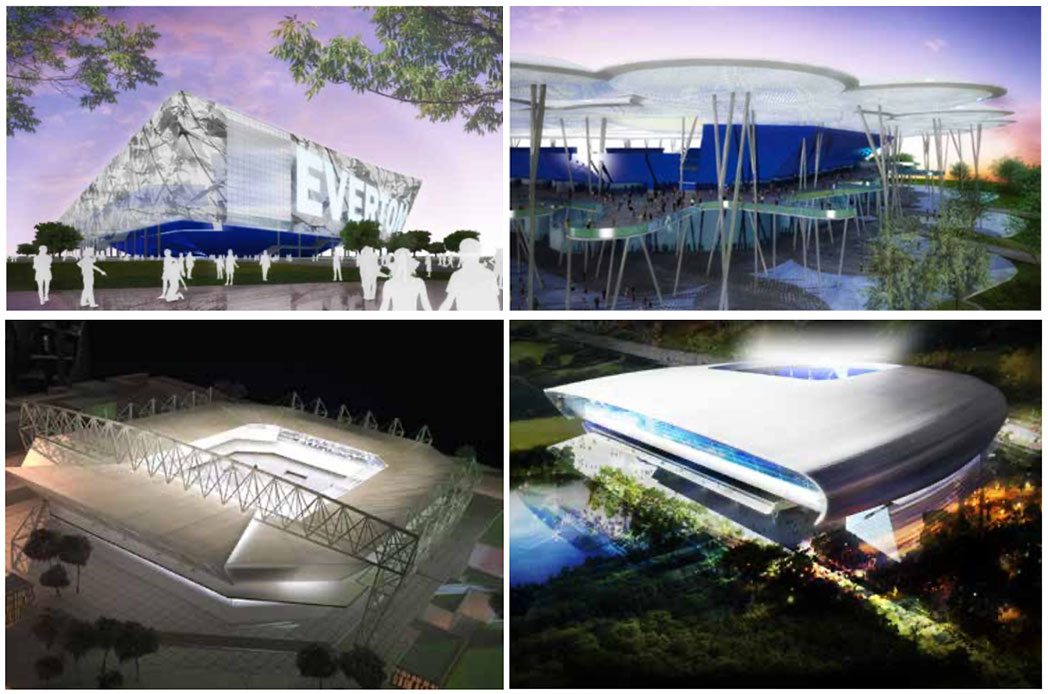
Meis Studio's four concepts as part of the 2015 Walton Hall Park feasibility study – clockwise from top left: Monolith scheme, Canopy scheme, Window scheme, Supertruss scheme
Given Everton's illustrious history, the club's list of "firsts", particularly where its home ground is concerned, and the magic of Goodison Park, few supporters, if any, anticipated or obsessed over the proposed design of their new stadium like Evertonians. That placed an enormous burden of expectation on Meis's team but it was a challenge he relished.
Originally briefed to come up with concepts for the Walton Hall Park site, Meis was eventually handed the job of coming up with an iconic design for a waterfront stadium on Liverpool's historic docks with all the connotations, inspiration and heritage sensitivities that entailed.
I believe that the historic fabric of the dock is a priceless asset that will help inform a state of the art stadium unlike any other on the planet and one that will capture the magic and memory of Goodison Park. I am striving for a design that feels like it "grew from the Docks" and can simultaneously look like it is from the future and yet has always been there.
Innovation doesn't always mean that a building has the latest bells and whistles, it can often be when a design is reduced to the very essence of its function.
Someone recently tweeted to me that modern English stadiums are no longer intimate or intimidating... that they can't be because of modern regulations etc. To that person I say, "just wait, and see".
Relieved of having to accommodate a running track and associated athletics facilities by Liverpool's failure to land the 2022 Commonwealth Games, Meis was able to focus first and foremost on designing a football stadium and, using one of the four concepts (the "Window Scheme") he and his team developed as part of the 2015 Walton Hall Park feasibility study, Meis crafted a design that incorporated a modern aesthetic with elements inspired to a great degree by the red-bricked surrounding architecture within the Stanley Dock Conservation Area.
The result was a structure that will feature a floating roof above a brick facade that retains the character of the docklands location, Liverpool's maritime heritage, and the waterfront's status as a Unesco World Heritage Site.
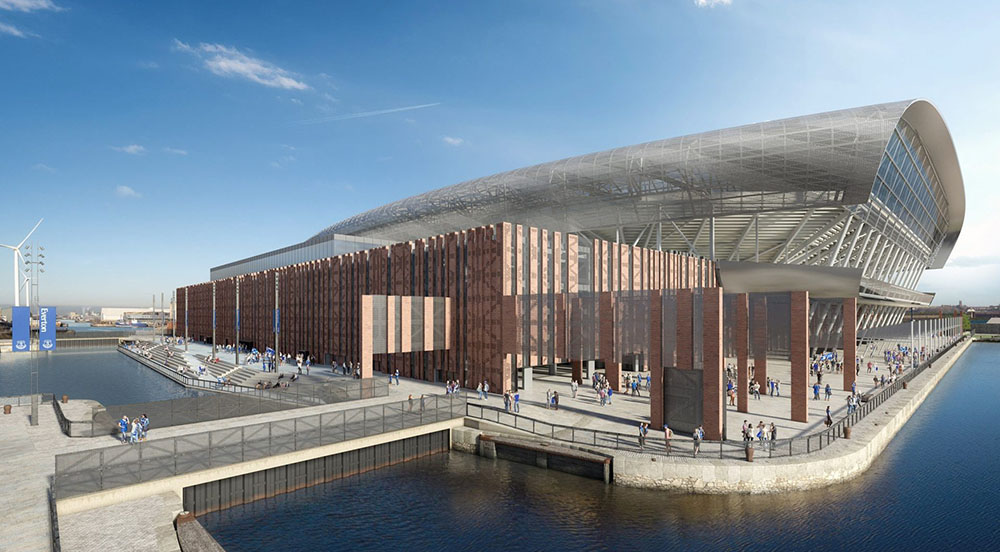
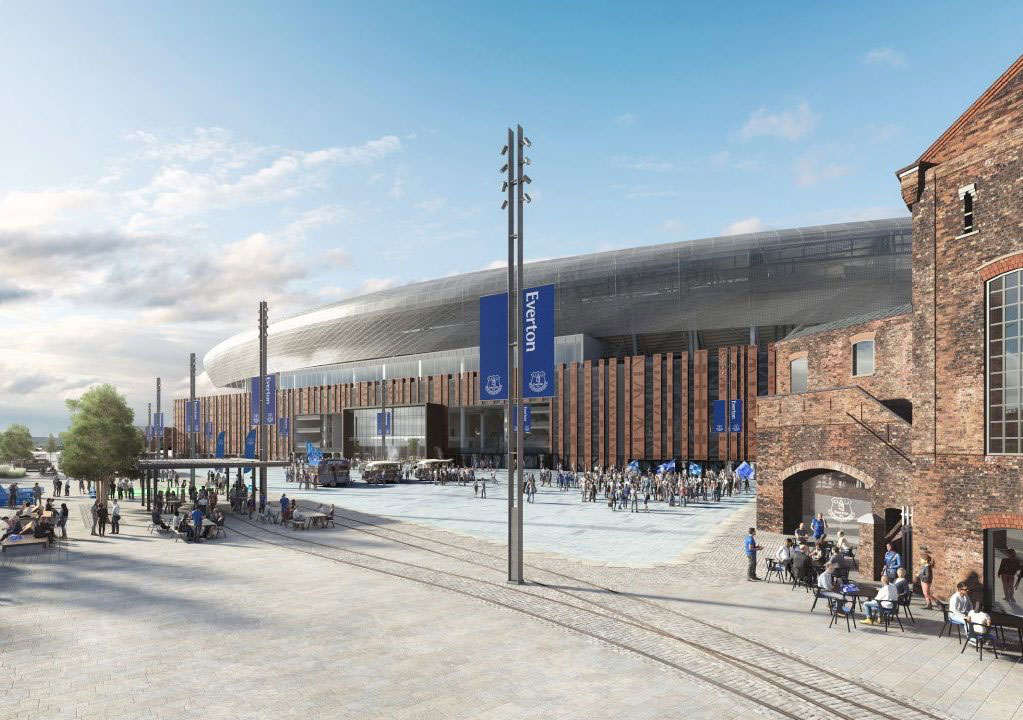
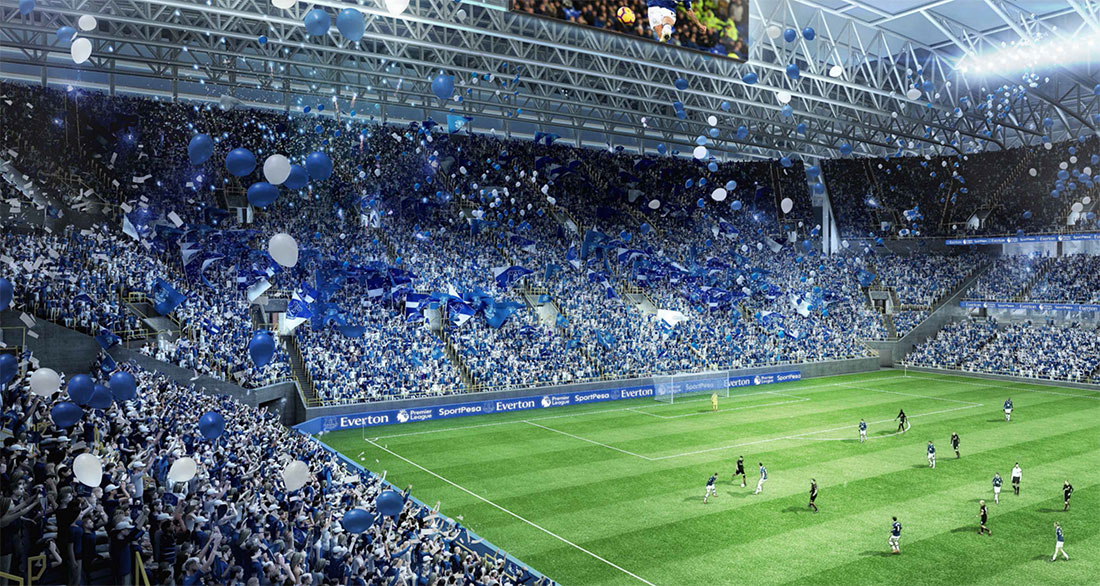
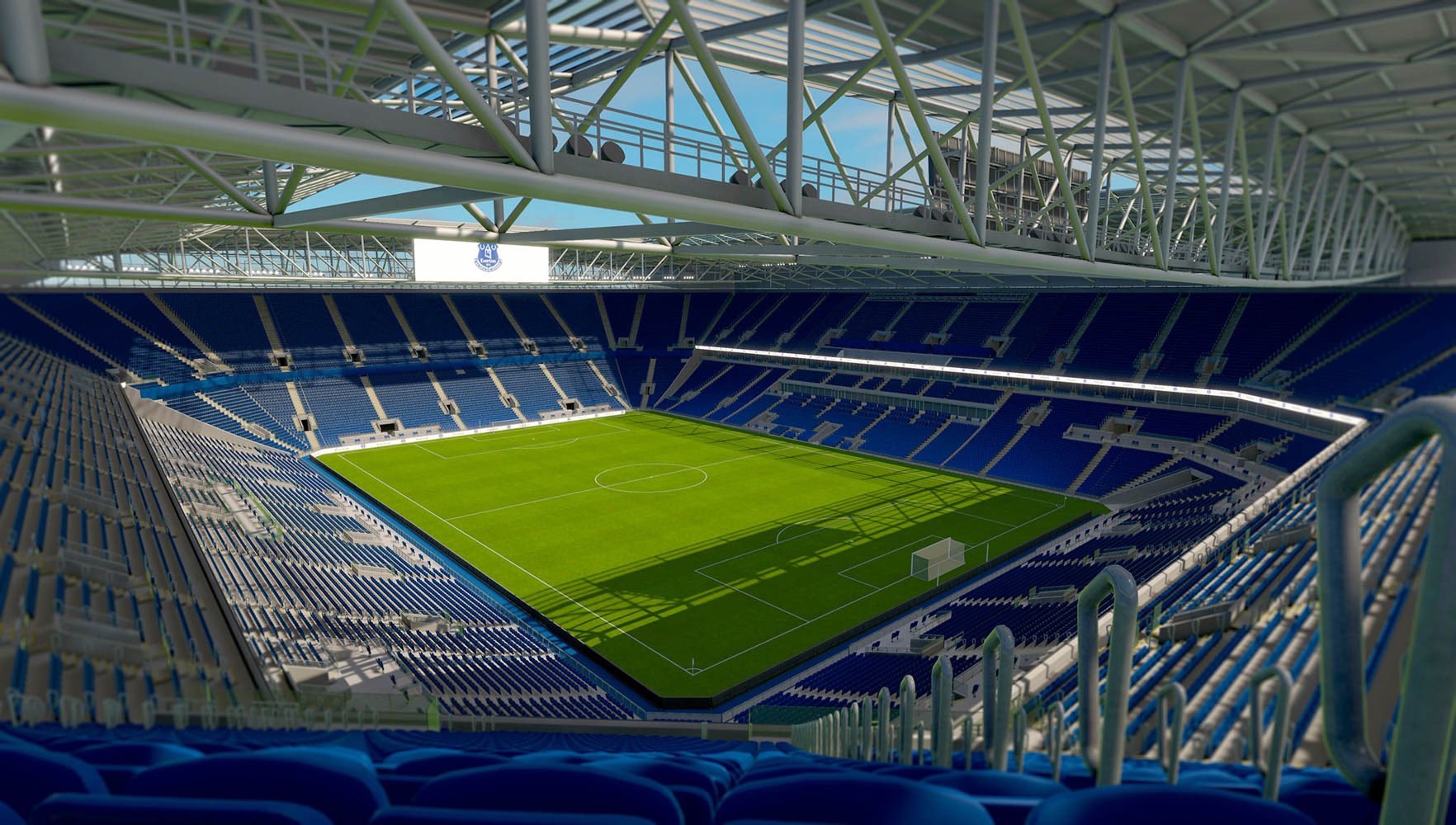
Construction
Everton and preferred contractor, Laing O'Rourke, will need to tackle challenges unique to recent new stadium construction in the Premier League in that Bramley-Moore Dock itself is still filled with water. As such, the site will require two stages of fish "rescue and translocation" before the dock is filled in with 480,000 cubic metres of dredged sand piped in from 23 nautical miles away in the Irish Sea.
Everton announced in December 2018 that they were planning for a ground holding 52,000 at Bramley-Moore Dock, with a final all-seated capacity of 52,888 outlined in the planning application.
The somewhat conservative capacity is significantly smaller than the 60,000 figure that was the most popular number among supporters during the consultation phase but it nonetheless represents an increase of over 12,000 on the seating capacity of Goodison Park.
The plans allow, however, for the installation of rail seating in both the South and North stands which, if approved for use in the Premier League, could allow for attendances as high as 62,000 when those sections are taken up by standing supporters.
"It is important to stress that this is our 'proposed' capacity and it is what we are currently working towards," said stadium director Colin Chong.
"We believe that our approach is the right one because it is commercially and financially sustainable and will mean that, in the long term, we will be able to increase the capacity should there be a demand and requirement to do so."
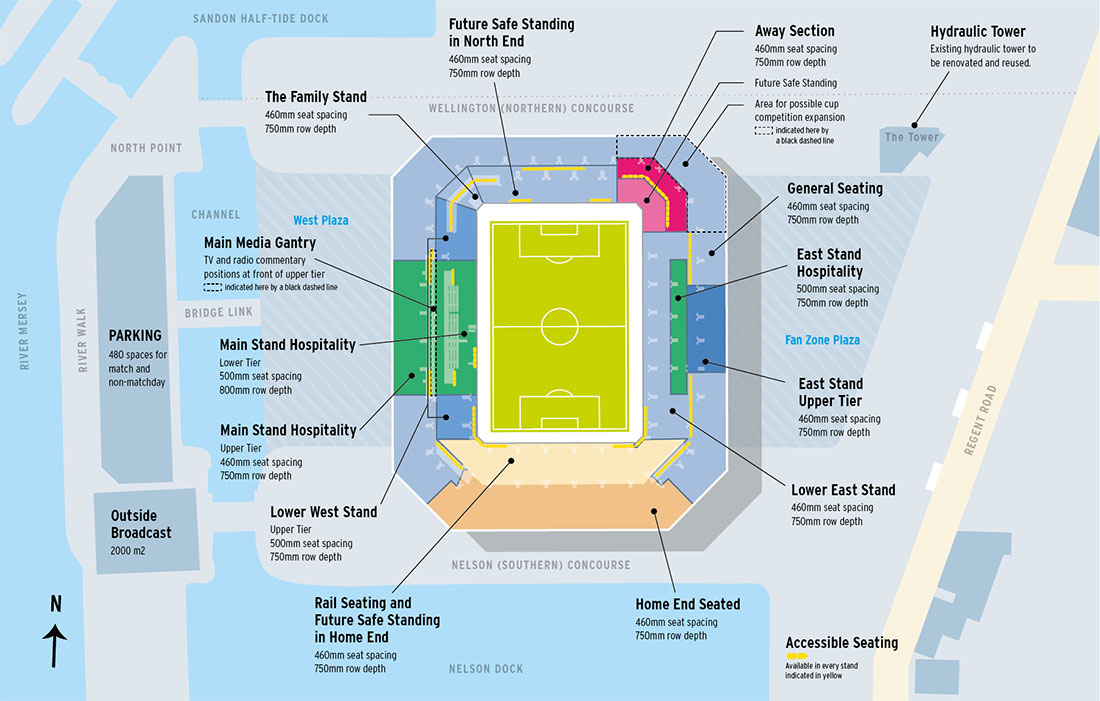
Layout of Everton's proposed stadium at Bramley-Moore Dock

Dredging and in-filling the dock was the first step before construction could begin
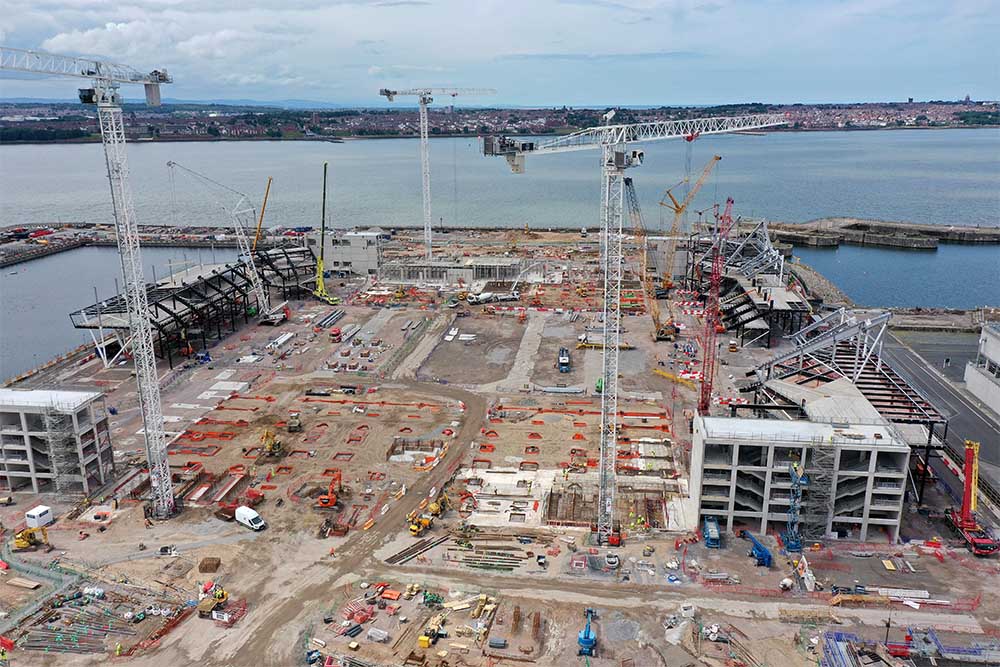
The first corner structures were erected over the summer of 2022
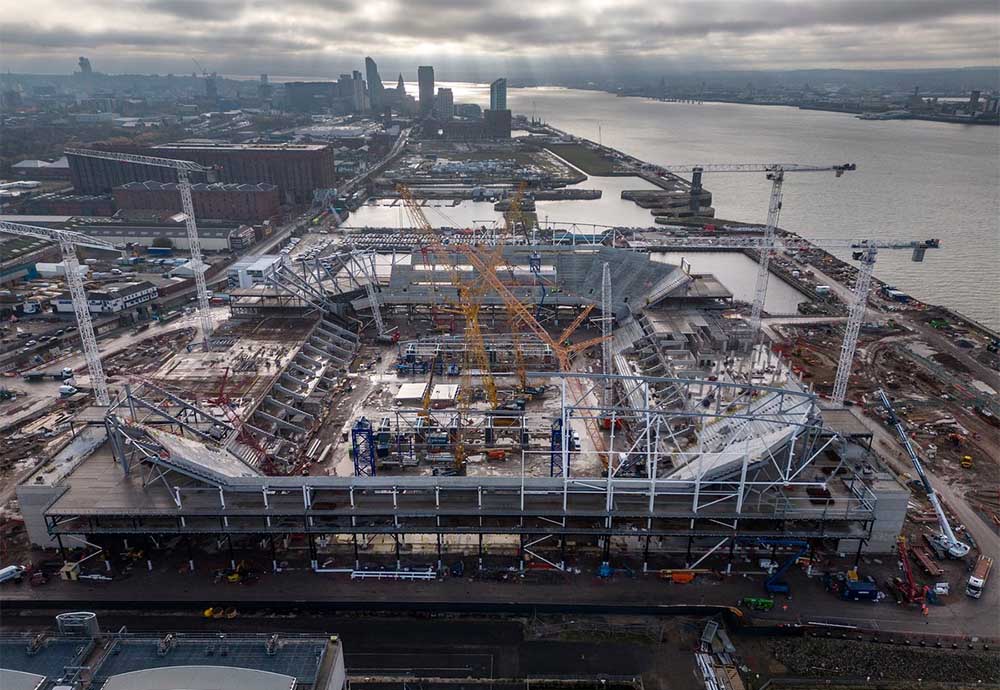
By November 2022, over a year into construction, the stadium was starting to take shape
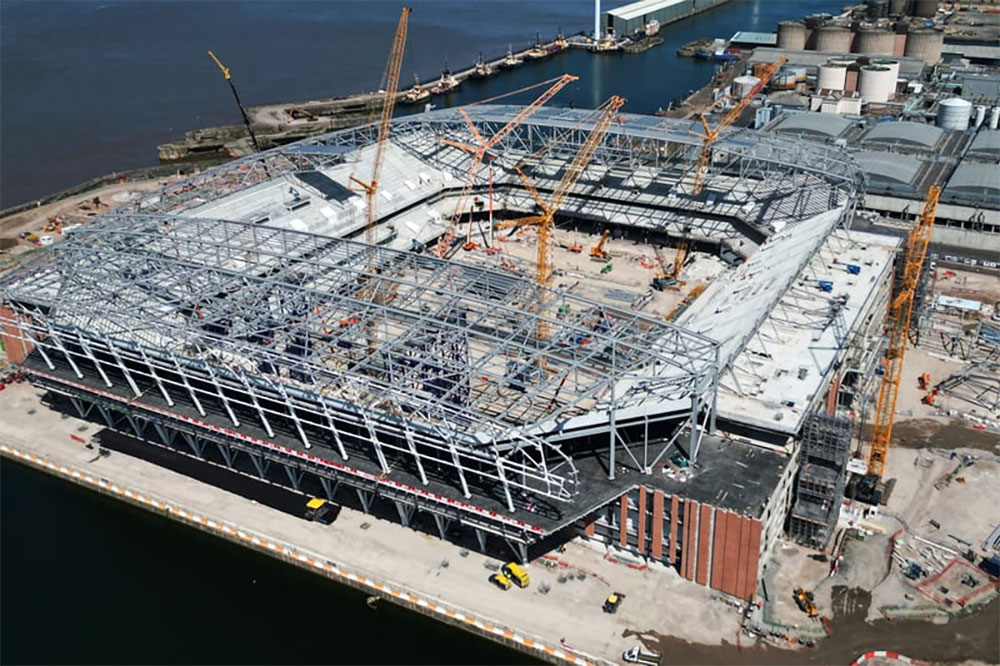
By the spring of 2023, the trusses were put in place ahead of installation of the curved metal roof panels
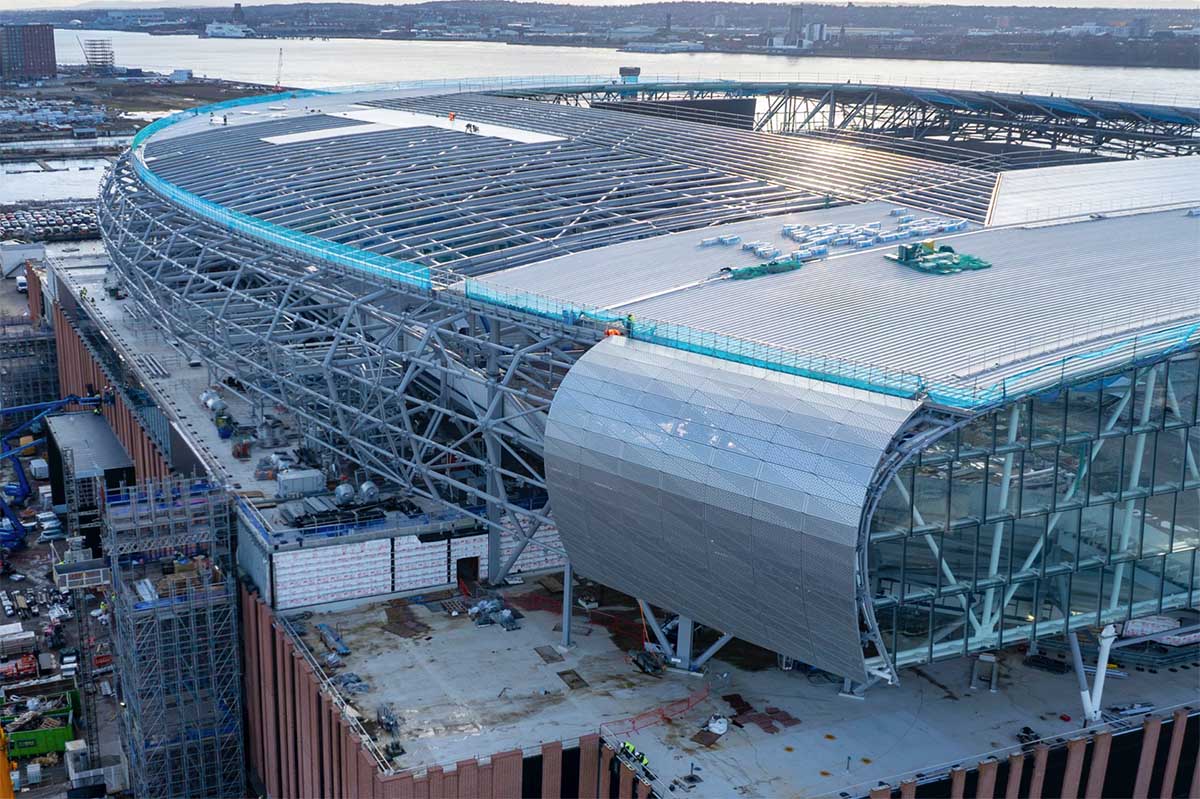
In late 2023 into early 2024, the aluminium barrel cladding was added to the roof of the ground
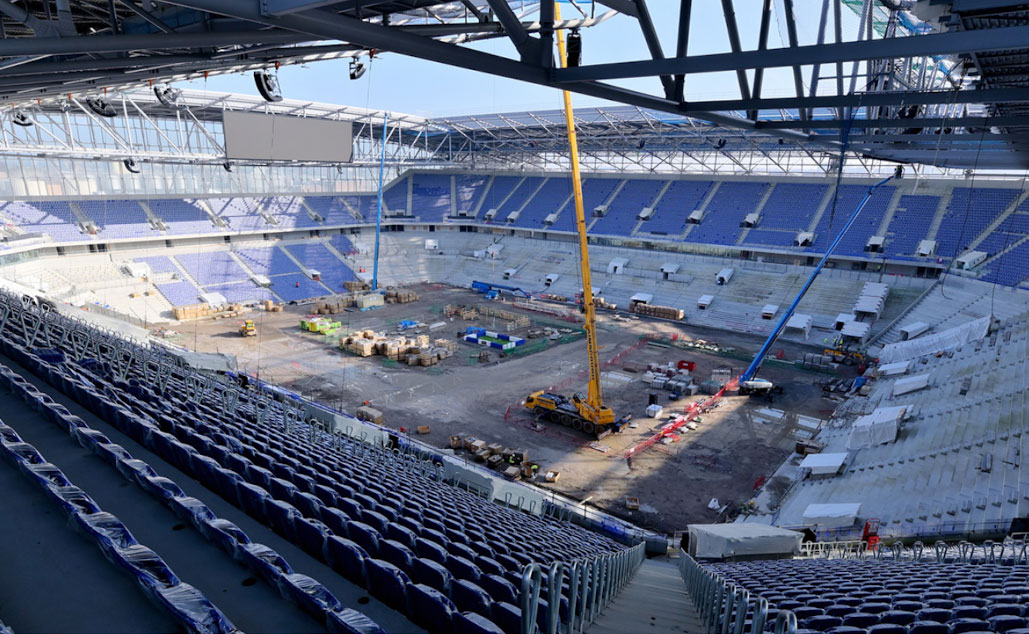
Meanwhile, inside, the final terracing segments were installed to complete the "bowl" of the stadium as more and more blue seats were bolted into place in each of the four stands
Costs
Between the time the project was initially mooted and the actual submission of the planning application, the final cost of Bramley-Moore Dock had risen from £300m to £500m, much of that due to the logistics of the dock site.
An “ambitious capacity” – a contentious term given that there are many Evertonians who feel that the club have opted for a smaller number of seats than could be filled – also increased the price tag of the stadium but the club remain confident they will recoup the outlay though a naming rights deal (USM Holdings have purchased a £30m first option on naming rights), further sponsorship, non-matchday revenue and higher attendances than are possible at Goodison Park.
"You will know we recently secured the Bramley Moore Dock site," former Chief Executive, Robert Elstone wrote to fans in a blog post on evertonfc.com in 2017. "Your informal feedback has ... informed the concept designs prepared by Meis needed to secure a reliable estimate of the project's total cost and, ultimately, our funding target.
"That funding target has escalated significantly and has occupied much of our efforts of the past 12 months. The premium for the waterfront site, an ambitious capacity that we will test with more rigour, a design we can all be proud of and the simple but painful impact of inflation, have all contributed to an increased overall cost and a funding target which continues to grow."
By January 2023, that final cost of the project, from infilling and preparation to the interior fit-out had risen to £760m, as admitted by Farhad Moshiri during an inteview with the Everton Fan Advisory Board.
Public Consultation
The first-stage public consultation into Everton FC's proposals for a new stadium at Bramley-Moore Dock and a community-led redevelopment of Goodison Park opened on Thursday 15 November 2018.
Under the campaign name "The People's Project", the consultation toured the city region for three weeks, visiting various locations in Liverpool and The Wirral. The consultations gave members of the public an opportunity to have their say on the principle of Bramley-Moore Dock becoming the site of Everton's new stadium and the Club's plans to leave a sustainable legacy at Goodison Park.
The club canvassed local residents, businesses and supporters over the possibility of building a brand new stadium at Bramley-Moore Dock as well as potential uses for their current home at Goodison Park. This included an online survey that anyone could take. And Open House walk-in sessions for residents and fans held in a number of different locations to guage people's feelings about "The People's Project".
The club released the results of the first part of their public consultation over plans to relocate their home ground to Liverpool's north docks. The survey found that 94 per cent of respondents agreed that the docks location was appropriate for the club's new ground, while 95 per cent agreed with the idea that Goodison should be re-developed to benefit the community once Everton leave.
There was similarly near-universal support for plans to hold other sporting, music or cultural events at Bramley-Moore Dock.
A second-phase consultation was conducted in July and August 2019.
Over 20,000 people responded during the first stage public consultation. The headline findings are as follows:
-
97% of respondents stated that it was important for Everton Football Club to remain in the City of Liverpool
-
86% of respondents stated that Everton should remain in North Liverpool
-
94% of respondents stated that BMD was an appropriate location for a new football stadium
Over 43,000 people participated in the second stage consultation. Key findings relating to BMD were as follows:
-
98% of respondents supported / strongly supported the proposed stadium design
-
96% of respondents supported / strongly supported the proposed reuse of historic features on the site
-
90% of respondents supported / strongly supported the proposed transport strategy
"These results are more than a vote of confidence in our plans," said CEO Denise Barrett-Baxendale.
"They show people recognise the transformational impact our stadium will have on North Liverpool and indeed the positive effect it will have on the wider city region.
"A new stadium will unlock a unique opportunity for our city region by delivering a £1bn boost to the economy, 15,000 jobs and an estimated 1.5m new visitors to the city as well as the regeneration of North Liverpool, including a community-led legacy at Goodison Park."

